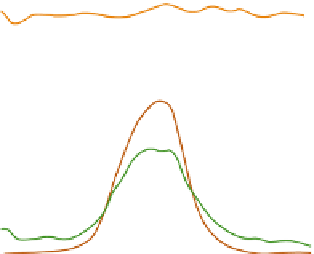Geoscience Reference
In-Depth Information
balances for rural and suburban locations. Rural
areas show considerable consumption of net
radiation (
Rn
) by evapotranspiration (
LE
) during
the day, giving lower temperatures than in the
suburbs. While the suburban gain of net radiation
is greater by day, the loss is greater during the
evening and night due to release of turbulent
sensible heat from the suburban fabric (i.e., Δ
S
negative). The diurnal energy balance for the dry
top of an urban canyon is symmetrical about
midday (
Figure 12.25C
) and two-thirds of the net
radiation is transferred into atmospheric sensible
heat and one-third into heat storage in the building
material (Δ
S
).
Figure 12.25A-C
explains this
energy balance symmetry in terms of the behavior
of its components (i.e., canyon floor, east-facing
wall and west-facing wall); these make up a white,
windowless urban canyon in early September
aligned north-south and with a canyon height
equal to its width. The east-facing wall receives the
first radiation in the early morning, reaching a
maximum at 10:00 hours, but being totally in
shadow after 12:00 hours. Total
Rn
is low because
the east-facing wall is often in shadow. The street
level (i.e., canyon floor) is sunlit only in the middle
of the day and
Rn
and
H
dispositions are
symmetrical. The third component of the urban
canyon total energy balance is the west-facing wall,
which is a mirror image (centered on noon) of
that of the east-facing wall. Consequently, the
symmetry of the street level energy balance and the
mirror images of the east- and west-facing walls
produce the symmetrical diurnal energy balance
of
Rn
,
H
and
(S
observed at the canyon top.
The thermal characteristics of urban areas
contrast strongly with those of the surrounding
countryside; the generally higher urban tempera-
tures are a result of the interaction of the following
factors:
(A)
E-facing wall
300
R
n
200
100
H
0
Δ
S
-100
(B)
Street level
R
n
400
300
H
200
100
Δ
S
LE
0
-100
(
C)
Canyon top
R
n
500
400
H
300
200
100
Δ
S
LE
0
-100
00
04
08
12
16
20
24
Hour
Figure 12.25
Diurnal variation of energy balance
components for a N-S-oriented urban canyon in
Vancouver, British Columbia, having white con-
crete walls, no windows, and a width/height ratio of
1:1, during the period 9-11 September 1973. A: The
average for the E-facing wall. B: The average for the
floor. C: Averages of fluxes through the canyon top.
Source: After Nunez and Oke, from Oke (1978). By permission
of Routledge and Methuen.
3
The production of heat by buildings, traffic
and industry.
4
The reduction of heat diffusion due to changes
in airflow patterns caused by urban surface
roughness.
5
The reduction in thermal energy required
for evaporation and transpiration due to the
surface character, rapid drainage and generally
lower wind speeds of urban areas.
1
Changes in the radiation balance due to
atmospheric composition.
2
Changes in the radiation balance due to the
albedo and thermal capacity of urban surface
materials, and to canyon geometry.
Consideration of the last two factors will be left to
D.3, this chapter.
The demand for energy to heat or cool houses
and businesses is measured by heating and cooling


































































